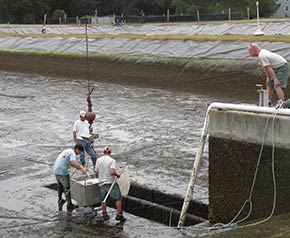About the Facility
The Waddell Mariculture Center is located at Victoria Bluff, a 1200-acre property which in 1979 was transferred to the South Carolina Department of Natural Resources by the State Ports Authority. Initial development of the Center incorporated 50 acres, with capacity for expansion to 150 acres. the remaining acreage has been placed in the South Carolina Heritage Trust Program to ensure preservation of the Area's natural resources.
The WMC complex includes a 10,000 square foot research building, which houses staff offices and a large wet lab. A 2,600 square foot maturation building isolates that activity. A pathology and histology laboratory is also separated from the other activities. There are about 25,000 square feet of outdoor tank pad plus maintenance building, equipment storage building, several greenhouses, feed storage building and silos, and pond sampling shed. An old plantation-style house on the site was restored and serves as a dormitory for visiting scientists and graduate students and a conference center where small seminars, meetings and training programs are held. Adjacent to the seawater pumping station is a 265' dock which provides water access to the Port Royal Sound estuarine system. The Center also has a 12-inch freshwater well for diluting seawater.
A variety of fiberglass tank systems are available including twenty-four 20' (diameter) tanks, twelve at 12', thirty-six at 11', twelve at 10', twelve at 6', plus miscellaneous smaller systems. The site includes twelve 0.25-acre ponds, ten 0.5-acre ponds, and three 1.25-acre ponds. The ponds are lined with high-density polyethylene which is overlain on the bottom with native soil. All ponds and tank systems can be supplied with seawater from the adjacent high-salinity estuary or freshwater from the well.
Depending upon current demands, various systems can be equipped with boilers and heat exchanger, water chilling units and/or varying degrees of filtration and water sterilization. The Center also has large live-feed production areas to produce phytoplankton and zooplankton for intensive larval rearing and bivalve conditioning.
 |
 |
 |
 |
